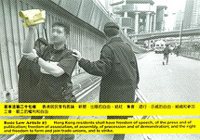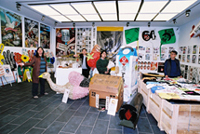|







|

An
exhibition about the freedom of indigenous cultural
and political expressions
“Hong Kong residents shall have freedom
of speech, of the press and of publication; freedom
of association of assembly, of procession and
of demonstration; and the right and freedom to
form and join trade unions, and to strike.”
Article 27 of the Basic
Law of the Hong Kong Special Administration
Region
of the People’s Republic of China |
There is, allegedly, a government department
or archive to house objects handed in by demonstrators
or objects the demonstrators left on the street.
These could easily be a huge collection of great
variety, ranging from the more common petition
letters and banners, to DIY objects such as broken
bowls, June-Fourth memorial, masks that bore the
faces of high ranking government officials, soiled
national and SAR flags, and carton coffins, fascinating
just to think about this.
There is, assumingly, a political agenda behind
the collection. Maybe they will be used as evidence
for some legal case. (In recent years the police
also took detailed video documentation of petition.
Are they trying to enrich the archive of this
specific aspect of community history with modern
technology?)
Social activists and pressure groups are not
the only ones who demonstrate. Government propaganda
by definition is closer than anything to a "demonstration".
The authority, endowed with abundant resources,
has a better show of force. This is what the community
activists cannot imagine to compare with. The
military rally on a national day is a good illustration
of this. During the time when Hong Kong was still
a British colony, statues were established all
around the city -- the statue of George VI at
the now Botanical Garden, the statue of Queen
Victoria, of course, in Victoria Park. The concrete
images of the rulers are everywhere over the colony.
After 1997, we have the Golden Bauhinia and the
Reunification Column. Though relatively abstract
in form, the message, claiming the possession
of the sovereignty, is always clear. What can
be a bigger "demonstration" than establishing
a "permanent" totem to say "this
place is mine"? It is no wonder in the headquarters
of a big corporation, the bust of the founder
is never missed. All these have become part of
our history of "public art".
There are various kinds of objects and totems
in social movement. In the June-Fourth candle
vigil each year, one can find in Victoria Park
the Democracy Goddess and the People's Heroes
Memorial, both modeled after the originals from
Tienanmen Square. When examined closely the Democracy
Goddess, one can find that the statue is actually
made of a wire skeleton and wrapped in fabric.
The temporality strikes a big contrast to the
Queen Victoria bronze statue on the same site.
Does the difference between government objects
and community objects of demonstration mainly
lie in their lifespan in public space? In the
preparation research for Objects of Demonstration,
we found that one of the most important elements
guiding the design of the object was to draw media
attention. It is not surprising that most objects
were lost or destroyed in the aftermath. If we
are looking for a collection of demonstration
objects, should we turn to the alleged government
archive – the biggest "museum of demonstration"?
The imaginary museum or the museum imaginary
is a blueprint for Objects of Demonstration.
To us, a group of cultural workers, the idea of
a collection immediately leads us to the association
of museum and exhibition. The collection is the
raw materials to a specific culture. It grows
with time, from the leather jacket of So Sau Chung
in the 67 upheaval to the recent SM parade of
Rainbow Action. These objects crystallize the
community's effort and intelligence. Collectively
they reflect the culture of demonstration and
document social issues over the years.
Demonstration examines and tests the boundary
of the freedom of expression in a society. It
traces and questions the power distribution. What
kind of observer and participant can an art worker
be? Objects of Demonstration extends the
brief social life of demonstration objects, and
tries to discuss, respond, re-organize and to
even demonstrate the culture of demonstration
beyond the news headline.
|